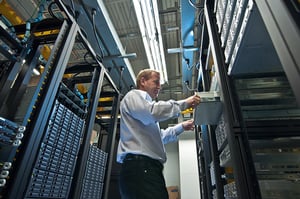Considering Scale-out Storage? Avoid Making These 6 Mistakes.
 New buzz words tend to come and go, especially as enterprise storage vendors promote their offerings to prospective customers. A few years’ back, we started to hear a lot about scale-out storage vs. scale-up storage. The popularity of scale-out storage has since grown, as have the questions about the difference between scale-up, scale-out, and related terms like hyperconverged and converged infrastructures.
New buzz words tend to come and go, especially as enterprise storage vendors promote their offerings to prospective customers. A few years’ back, we started to hear a lot about scale-out storage vs. scale-up storage. The popularity of scale-out storage has since grown, as have the questions about the difference between scale-up, scale-out, and related terms like hyperconverged and converged infrastructures.
At WEI, we’ve learned a few things in our efforts to help customers make sense of the sometimes murky area of scale-out storage. Here, we present 6 mistakes to avoid when considering whether or not to make a move with scale-out storage. Not surprisingly, some of the mistakes we see are more generic, while others relate more specifically to one vendor’s solutions.
Mistake #1: Not Understanding the Difference Between Scale-Out vs. Scale-Up
The first mistake comes back to a lack of knowledge about the main difference between scale-out and scale-up storage. Internet research on the subject will offer a variety of definitions. When asked by our customers, we try to simplify the difference as follows:
- Scale-up storage: Let’s you grow disk capacity (more disks), without having to add a preset amount more of CPU, controllers, or memory. Scale-up storage is often part of a Converged Infrastructure (CI) since it commonly supports legacy and emerging applications in the data center.
- Scale-out storage: Simultaneously grows your disk capacity and performance by pairing added disk storage with a set amount of CPU, memory, and controllers, often within the same “box”. Hyperconverged Infrastructures (HCI) and clustered storage are examples of scale-out storage. Scale-out storage, like that in hyperconverged infrastructures, often successfully supports small businesses, smaller satellite offices, or companies whose storage and CPU growth needs are expected to scale in a linear fashion. Unfortunately, the capacity and performance growth needs for most companies are not always linear.
Mistake #2: Paying for More Storage Than You Need
Scale-out storage solutions can be very fast and agile. But, caution with scale-out is still prudent. We’ve seen some clients do well with their first HCI scale-out storage box, but then overpay as they add more boxes to their cluster. While a scale-out storage cluster may be exactly right for one customer, it can be overkill for another.
Good questions to ask about future growth include:
- How much more memory will our current and future workloads really need?
- How many more CPUs will our current and future workloads really need?
- How much more disk capacity will our current and future workloads really need?
As you grow, it’s important to be careful not to pay more for resources you don’t really need. If needed, seek help matching your estimated growth profile to the right storage platform.
Scale-Out Storage Has Its Challenges
“Scale-out designs are not easy. They may do well for the first two to four nodes, but if I am creating a large-scale hybrid cloud, then the environment needs to scale efficiently and resiliently. We have seen environments that fail on both counts."[1]
—Camberley Bates, Analyst/Partner, The Evaluator Group
Mistake #3: Not Following Vendor Best Practices
Scale-out storage solutions often have very vendor-specific guidelines about how best to deploy them in your environment. Sometimes, we encounter an IT organization that has deployed a scale-out system but is not seeing the expected benefits of its use. On further assessment of the situation, we often find the way the system was deployed does not add up to the vendor’s reference architecture or best practices.
For example, one customer tried to deploy a Dell EqualLogic system for scale-out storage. Unfortunately, they neglected to follow vendor best practices for Maximum Transmission Unit (MTU) sizing and switching. This resulted in poor performance and connectivity issues.
Mistake #4: Not Ensuring Redundancy
Enterprise storage is often about ensuring RAS (Reliability, Availability, and Serviceability). On the availability front, this means ensuring there are enough redundant parts available to counteract one or more other parts going down. RAID is a key example of this type of redundancy. How you deploy a scale-out storage solution must also give you sufficient redundancy in the event of downtime of one or more system components.
Some vendors are stronger on this front than others. For instance, one vendor of scale-out storage allows you to grow to four storage arrays, but using RAID 0. This means if one array goes down, you could lose all your data on the array. When evaluating scale-out storage, ask the vendor about redundancy and downtime scenarios as you grow, including what happens if one (or more) of their arrays goes down.
Mistake #5: Cheap Connections Can Breed Performance Problems
There’s another use case specific to scale-out storage on iSCSI networks. Here, when you need to add new iSCSI devices, we see companies sometimes trying to save money by adding more devices to newer, cheaper network switches. This can create an I/O performance problem as data jumps between different switches.
For example, some may try to attach extra iSCSI devices using something like a Cisco FEX (Fabric Extender). Unfortunately, FEXes are not built to tie iSCSI devices together and can cause a lot of network chatter. Ideally, for the best performance with your scale-out storage, we recommend that iSCSI devices all be connected to the same switch. We also recommend the switch be vendor-agnostic.
Mistake #6: Wrong Advice; Wrong Start
Lastly, we often find most mistakes made about infrastructure start from an incomplete picture of an organization’s requirements. This is also true when an IT team evaluates or considers deploying some type of scale-out storage. Vendor information can be golden in the evaluation process but it can also benefit from a healthy dose of third-party expertise. Here, it can be hard to know the right move without first getting advice from multiple sources. Trust is a key factor when soliciting advice from vendors, resellers and partners.
Make sure your partner has your best interests at heart. At WEI, we often go above and beyond to make sure you get the right answers and the best solution for your unique requirements.
We’d be happy to help you sort out the pros and cons of enterprise storage evaluation and buying, including scale-out or scale-up storage. Contact us to have your enterprise storage questions answered.
Sources:
[1] “Four Software-Defined Storage Trends,” by Cynthia Harvey, Network Computing, Jan. 30, 2017, https://www.networkcomputing.com/data-centers/4-software-defined-storage-trends/1057050245.
About WEI
WEI is an innovative, full service, customer-centric IT solutions provider.
Why WEI? We go further.
At WEI, we’re passionate about solving your technology problems and helping you drive your desired business outcomes. We believe in challenging the status quo and thinking differently. There are a lot of companies that can take today’s technology and create a great IT solution for you. But we do more. We go further. And we have the customer, vendor and industry awards to prove it. WEI is a premier technology partner, who always puts our customers first while providing the most innovative solutions for over 30 years.


